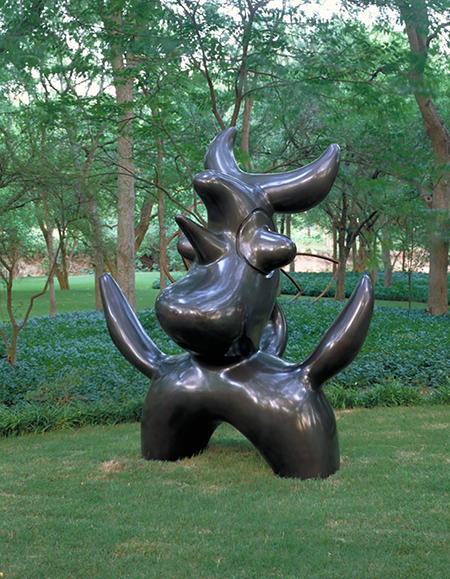
Continuing through September 26, 2021
Many of the things we’ve come to understand about life during a pandemic have been thought through and addressed by curators at the Nasher Sculpture Center in their first major exhibition since the museum closed for several months last year. In “Nasher Mixtape,” instead of depending on lenders or outside cooperation of any kind, the Center looks inward, toward its own holdings, for a show in which a third of the pieces are either new to the collection or otherwise have never been on view to the public. Since last March we have all been forced to consider some form of life in isolation, the importance of the outdoors, and the true value of friends and family, especially when we experience a loss during these intensely fragile and distanced times.
The idea for the exhibition comes from a common and widespread practice that began in the ’80’s, of recording a list of songs on a cassette tape. This mixtape usually had some theme important to the person who recorded it that they wanted to share with friends or family. The practice continued with compact discs and endures today in play-lists. An obvious nostalgia permeates it, perhaps for a simpler time. It is inversely suggestive of a time beyond its moment when we reach the other side of life’s timeline, seeing differences in ourselves through the music of our youth. “Nasher Mixtape” analogously offers a compilation of nine tracks of art, each track representing a specific theme.
Starting at the entrance, track 1, “Into the Garden,” leads us through nature as seen mostly through the lens of Surrealism. Max Ernst’s “Sister Souls (Les Ames-Soeurs)” is a delicately formed bronze with stalks from the vegetal world seem to talk to each other. They form a trio of pieces that take us through the gallery and out to the garden beyond. David Smith’s “The Forrest,” painted steel on a wood base, features long, tall forms that look like trees rising up from the plantlike forms at the base. These in turn interact with a Nasher treasure set center stage, inside the gallery. Usually out in the garden, Joan Miro’s “Moonbird (Oiseau lunaire)” joins the party, a reminder of the interplay between interior and exterior, visualizing a polarity that defines our lives during the pandemic.
In another gallery, track 4, “Force of Nature,” sits Maren Hassinger’s “Field,” a recent acquisition. Long waves of wire rope ascend from a concrete base as if they’re blowing in the wind. Their motion is countered by Mexican artist Bosco Sodi’s quite static and grounded arrangement of orange clay timbers, “Wall (Muro).”
An arrangement of four sculptures and two drawings by Melvin Edwards personify the subject of track 6, “Now We Know.” A gift to the Nasher from the artist and on view for the first time, they faithfully represent a career that spans decades. Unmistakably committed to addressing the Black experience in America, the pieces express aggression, confinement and mortality directly related to the struggle for equal rights and the acknowledgement of a common human dignity. These messages are universal and multivalent, but also topical in our natural inclination to relate them to this sequestered time, powerless to prevent countless lives needlessly lost due to inaction on the part of the federal government.
Track 9, “Love and Delight” concludes “Nasher Mixtape” in the downstairs gallery with a spirit of healing. A playful selection of hits from the collection illustrate connections between the founders of the Center and how they gave each other works of art as gifts to celebrate their personal bonds and love of art. Relationships are also traced from piece to piece along the lines of the artists themselves. Works by Jean Arp, Constantin Brancusi, Nancy Grossman and Isamu Noguchi, all well known to frequent museum visitors, are joined by rarely seen pieces by Jean-Michel Basquiat and Beverly Pepper.
This celebration of a private collection housed in a publicly accessible institutional space feels like an emotional coming together now more than it would in an ordinary time. By September, when the show ends its run, the respite and wonderment “Nasher Mixtape” affords will hopefully give way to and signify a welcome return to a new normality.
